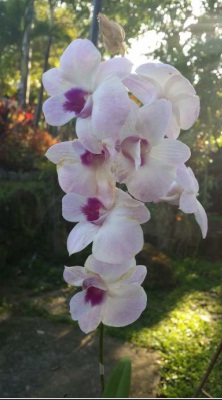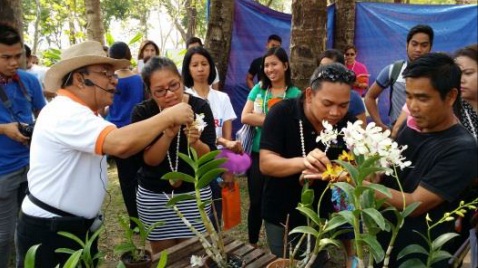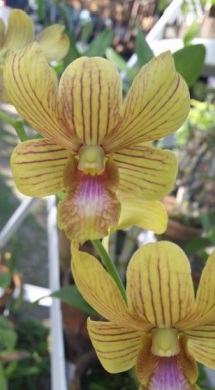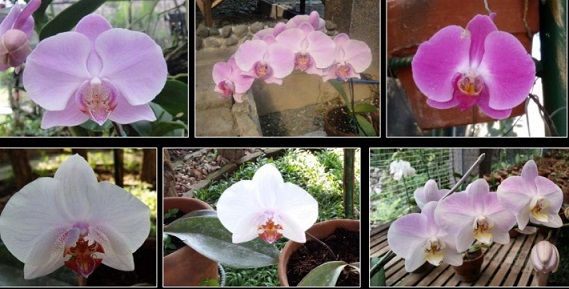BY CHICKIE R. LOCSIN

“GOD must have loved our country so much because of the 25,000 varieties of orchids in the world, around 1800 are indigenous to the Philippines,” exults Jun Anota, Executive Director of the Nayong Pilipino (NP).
And the beautiful thing about it is that almost all of the 1,800 indigenous Philippine varities are found in the Nayong Pilipino orchidarium.
With more than 130,000 orchid plants of different species, the orchidarium of the Nayong Pilipino has become the centerpiece of its new facility in Clark. A second but no less impressive satellite orchidarium is located in Luneta, behind the National Museum.
With the incredible elegance of the orchids in bloom, the Orchidarium in both locations showcases the best of Philippine flora.
It also provides serious orchid enthusiasts the opportunity to learn cross pollination techniques and experience creating their own unique plant.
This project marks the first time that local orchids are grown and propagated in commercial quantities in a laboratory. The Nayong Pilipino agriculturists have propagated 45 new orchid species, which includes 12 phalaenopsis and 16 dendrobiums. Nineteen of these have been submitted to the Bureau of Plants for registration, but the process of validation is very extensive and more than a year later, NP has not received confirmation from the BoP.
Benson Luis, head orchidologist of Nayon Pilipino is bothered by the bureaucratic delay. He bewails the fact that “Foreigners ransacked Philippine forests in the eighteenth and nineteenth century, and with substantial funding, developed and propagated these orchids and claimed them as flora of their own country. Due to a lack of funding and interest to register our native ornamental plants, the Philippines has lost its claim on these native orchids as part of Philippine flora.”

With great zeal, both Anota and Luis, through the NP, are determined to reverse this trend and realize their dream of building up the largest orchid forest in the world. Hence, the sustained effort of NP to create new hybrids and naming these after Philippine historical figures to highlight the orchids’ identities.
Benson is meticulous about the “legitimacy” of orchid mother plants which they cross pollinate and makes sure that Nayong Pilipino purchases only from reputable commercial orchid growers like the Malvarosa and Purificacion nurseries, importers of orchids that were originally indigenous to the Philippines. One of the phalaenopsis hybrids Benson personally developed is a cross between a pinkish/purple flower and a white and yellow flower, which shall be named Nayon Pilipino I. He will only know the color and appearance of his “baby” in two years time when it blooms.
The NP nursery has approximately 20,000 seeds of cattleya and two thousand seeds of dendrobiums. Benson reveals that to cut on costs, the seeds are incubated in used but well sterilized bottles of ketchup and gin then moved into a highly sanitized inoculating chamber to ensure that there is no chance for germs and pests to infect the seeds. Orchid pods are fed with exact measurements of various chemicals and at a later stage these are supplemented with coconut water, saba for potassium and other organic foods. Cattleyas have a 12-month gestation period and takes four to five years to bloom, while dendrobiums take eight months to grow and three years to bloom.

he work done in the NP orchidarium is accomplished by two primary orchidologists assisted by three staff members dedicated to the delicate care and maintenance of the orchids. Even after the plants are grown and placed in individual pots, the agriculturists in charge of maintenance place nets over the young plants in the greenhouse as a permanent protection against various pests, foremost of which are spider mites that are brought in by strong winds during the rainy season.
NP agriculturist Reina Die shares a tip to fight spider mites :“ We experimented and found that we can destroy these wind-borne pests with a home remedy consisting of a small amount of detergent dissolved in large pail of water. This is used to water the plant but should be done only in the afternoon when the sun has gone down so as not to burn the plants.”
Benson said his passion for orchids come from his father who was in charge of the nursery in the original Nayong Pilipino in NAIA I where their family was allowed to live on the premises.
After school he too worked with NP, from 1990-1999 during which time the orchidarium had built up a nursery of 300,000 plants. He does not know what happened to these orchids in the interim but when he returned to NP in 2010 to work with Anota, they had to start from scratch in building up the present inventory of 130,000 plants. “ The food on the table which my father fed us was from Nayong Pilipino so I owe them so much. I want to give back by helping to build up the orchidarium and training everyone who works here to learn how to propagate it in a lab. Some of them never took up biology in school but if they are interested they will learn and have a skill that they can use.”
Orchid lovers can sleep well knowing that the amazing array of pretty pink, purple, yellow and green orchids of Nayong Pilipino are in good hands.
